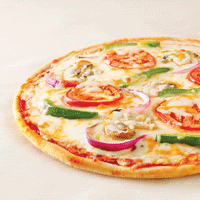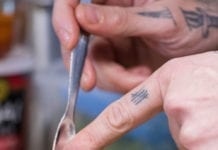In 2008, years before gluten-free offerings became the talk of the foodservice industry, Pizza Pizza boldly took the industry lead with its introduction of gluten-free (GF) pizza crust and toppings. Recently F&H caught up with Pat Finelli, chief marketing officer at Pizza Pizza, to discuss the company’s proactive stance with regard to adding healthier items to the menu. Additionally, following the Q&A, we’ve also included our analysis of what Pizza Pizza has done; and finally, we’ve provided insight into what can be further done to improve the company’s offerings.
F&H: What’s been the response to your gluten-free pizza program?
Pat Finelli: It’s been a good business decision. In our first full year, after the launch, we sold 150,000 GF pizzas and have experienced double-digit growth every year since. Families appreciate the benefit of being able to order both gluten-free and regular pizza from their local Pizza Pizza outlet. It’s really been a feel-good program for us on the product development side and a win-win for customers and the company.
F&H: Is your staff engaged in making these changes?
PF: We are in the people business and, as a QSR, we want to be a one-stop shop so all our customers — whether they are looking for a healthier option or a traditional favourite — can find an appealing selection. We listen and monitor eating trends and then adapt accordingly. We have been proactive on the issue of healthier eating — first with the gluten-free initiative, then with the Health Check program.
We were the first nationally branded pizza chain to be certified compliant with the Ontario School Nutrition PPM 150 policy. We are now testing “fresco,” a whole-grain thin crust fresh ingredients pizza program. We are constantly innovating and adapting.
F&H: What percentage of company sales are derived from healthier options?
PF: Twelve to 15 per cent of our sales come from healthier items — that includes the gluten-free pizzas and our Health Check items. Our pizzas are peanut-free and trans-fat free.
F&H: Your pizzas are still very high in sodium. Have you made progress reducing sodium content?
PF: Working with our suppliers, we started gradually reducing sodium in our ingredients about five years ago. In the past two years, we have reduced sodium in our tomato sauce by 10 per cent, in our whole-grain crust by 25 per cent and in our Classic Pepperoni by five per cent. We are using the whole-grain crust on our new “fresco” pizza, which is designed for customers wanting a lighter, healthier pizza. We are focused on having something that appeals to all of our customers.
F&H: Does Pizza Pizza staff know the ingredients included in your menu items?
PF: We have ongoing staff training programs. Because the information is on our website, if there are questions, they should go to the computer and print out the information requested. We find we can’t keep up with having printed brochures in the store, but staff should print them out for any customer.
F&H: What is driving your stance on healthy-eating initiatives? They take time and investment. Is it sustainable?
PF: We think it’s the right thing to do. It’s responsible, and it’s good for business. When someone calls in an order, it is often mixed — one gluten free; one regular. We want to be that one-stop QSR for them offering great-tasting pizza. We have to keep inventing new menu items to adapt to the changing marketplace.
The Analysis:
Pizza Pizza used its gluten-free pizza program to reach its customers who identify themselves as gluten-sensitive or gluten-intolerant. Such a program presents a unique challenge for restaurants offering menu selections that are wheat-flour based, but the investment has paid off at Pizza Pizza.
The chain also supports the Heart and Stroke Foundation Health Check program, which is available to any foodservice organization. The Heart and Stroke Foundation dietitians review the menu items listed on the menu, including the portion size. Those that meet nutrient criteria, developed by Health Check based on recommendations in Canada’s Food Guide, are approved to be labelled with the Health Check logo. A fee is paid to help run this voluntary, not-for-profit program. (To obtain more information, visit healthcheck.org.)
When examining Pizza Pizza menu items, six met the Health Check criteria. Prudently, Pizza Pizza provides a cautionary note on its website, which explains that a Health Check serving is two slices of a medium Health Check pizza. If this item is customized or an ‘add on’ is included it will no longer meet Health Check criteria.
Another positive aspect of Pizza Pizza’s approach is that it lists its nutritional information for its menu items online.
The nutrient analysis was undertaken by Mississauga Ont.-based Maxxam Analytics Inc., an accredited Canadian independent testing laboratory using Pizza Pizza-provided ingredient information. Nutrition information was obtained through Genesis R & D Nutritional Labeling Software, which is also accredited software that accesses the USDA and Canadian Nutrient file. These facts are identified on the company’s website. It’s very important to use credible sources for obtaining the nutrient information to be provided to customers so they can have confidence in the information.
Pizza Pizza’s ingredient listing is also important information for people with allergies. The 11 common allergens are identified on the chain’s website, and the menu items that contain allergens are listed. But, because many people have rare allergies or food sensitivities, it’s best to provide complete ingredient information per menu item as Pizza Pizza has also done.
Using a website to provide this information is a practical approach, especially with the more affordable and readily available new digital handhelds that provide rapid access to websites. Increasingly, customers who eat out regularly will use these tools to ensure their safety and reduce their stress levels when eating out. This doesn’t, however, preclude the need for proactive staff training. “I don’t know” or a helpless shrug from wait staff can diminish the investment in a well-documented website readily accessible to the customer.
Next Steps
Pizza Pizza has done a commendable job promoting healthy-eating initiatives, although the salt (sodium) content in many of its popular menu items remains high. High levels of sodium are found in deli meat toppings, cheese and in the regular crust. The new sodium guidelines suggest a daily intake of 2,300 to 2,700 mg for adults. Meanwhile, an in-store Pizza Pizza slice (a larger portion, which likely represents the typical quantity of pizza consumed per meal) contains almost 70 per cent or more of the daily recommended intake. Using its enormous purchasing power, Pizza Pizza could help everyone by working with its suppliers to further reduce the sodium content of its toppings and crusts by another 25 per cent while still retaining the flavour and appeal.
Every other month the Analyze This column offers nutrient, allergen, costs and ingredient traceablility issues on a range of recipes. It’s provided by the Oakville, Ont.-based Food Systems Consulting Inc. and is completed by registered dietitians with access to the Canadian Nutrient file and Computrition software. For more information, visit foodsystems.com.
Keep Reading





















